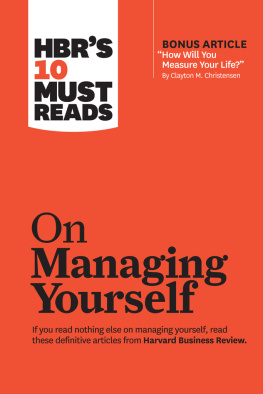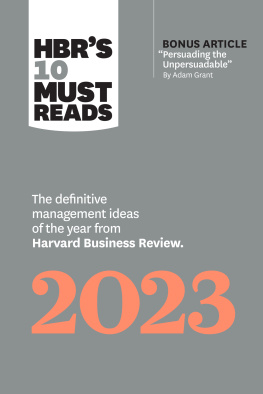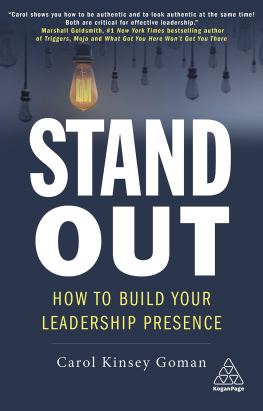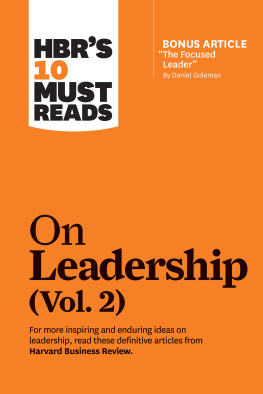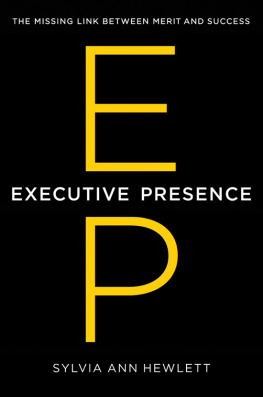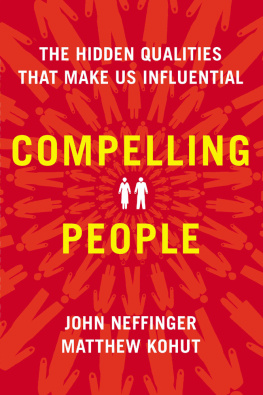HBR Press Quantity Sales Discounts
Harvard Business Review Press titles are available at significant quantity discounts when purchased in bulk for client gifts, sales promotions, and premiums. Special editions, including books with corporate logos, customized covers, and letters from the company or CEO printed in the front matter, as well as excerpts of existing books, can also be created in large quantities for special needs.
For details and discount information for both print and ebook formats, contact .
Copyright 2018 Harvard Business School Publishing Corporation
All rights reserved
Printed in the United States of America
10 9 8 7 6 5 4 3 2 1
No part of this publication may be reproduced, stored in or introduced into a retrieval system, or transmitted, in any form, or by any means (electronic, mechanical, photocopying, recording, or otherwise), without the prior permission of the publisher. Requests for permission should be directed to , or mailed to Permissions, Harvard Business School Publishing, 60 Harvard Way, Boston, Massachusetts 02163.
The web addresses referenced in this book were live and correct at the time of the books publication but may be subject to change.
Library of Congress Cataloging-in-Publication Data
Title: Leadership presence.
Other titles: HBR emotional intelligence series.
Description: Boston, Massachusetts : Harvard Business Review Press, [2018] | Series: HBR emotional intelligence series
Identifiers: LCCN 2017054135 | ISBN 9781633696242 (pbk. : alk. paper) | ISBN 9781633696259 (ebook)
Subjects: LCSH: Leadership. | Executive ability. | Emotional intelligence.
Classification: LCC HD57.7 .L4347 2018 | DDC 658.4/092--dc23 LC record available at https://lccn.loc.gov/2017054135
The paper used in this publication meets the requirements of the American National Standard for Permanence of Paper for Publications and Documents in Libraries and Archives Z39.48-1992.
Contents
What is this ephemeral quality?
By John Beeson
Understand the impact you have on others.
By Amy Jen Su
Think strategically about your communication.
By Rebecca Shambaugh
Avoid ruling through fear.
By Amy J. C. Cuddy, Matthew Kohut, and John Neffinger
The classic on conveying competence and confidence.
By Deborah Tannen
The costs can outweigh the benefits.
By Jasmine Vergauwe, Bart Wille, Joeri Hofmans, Robert B. Kaiser, and Filip De Fruyt
Leadership Presence
HBR EMOTIONAL INTELLIGENCE SERIES
1
Deconstructing Executive Presence
By John Beeson
If you ask a group of managers who aspire to the C-suite what it takes to get there, theyll invariably mention executive presence, but they arent always so clear about what it means. Not too long ago, I conducted a series of off-the-record interviews with senior executives responsible for executive placement in their organizations. I asked them about the make or break factors they consider in making C-suite promotion decisions. Executive presence was one of the handful of decision criteria they cited, but even these experienced executives struggled to define what it is and why one person has it and another doesnt. In an increasingly diverse world where senior executives are no longer all six-feet-two-inch males who look like they were sent from central casting, what does it take to create a commanding executive presence? The right clothes? A firm handshake? Those matter, but they dont tell the whole story.
Although executive presence is highly intuitive and difficult to pin down, it ultimately boils down to your ability to project mature self-confidence, a sense that you can take control of difficult, unpredictable situations; make tough decisions in a timely way and hold your own with other talented and strong-willed members of the executive team. If thats the nub of the issue, what style, what behaviors combine to signal that level of self-confidence to others? For some answers, consider three talented managerstwo of whom didnt make it to the executive level and one who did.
Every manager would love to have a Frank Simmons on his or her management team. Experienced, results oriented, collaborative, and committed to the company, Frank showed up on succession lists for a number of years, but was never promoted. Although a top performer in his area, Frank always looked a little rumpled and his posture was a bit hunched. When he made presentations to the executive team, he was invariably well prepared, but his lack of comfort was evident in his body language. Normally highly articulate, his presentations were long-winded and rambling. In the Q&A portion of his presentations, he tended to be overly deferential to members of the executive team, and he was hesitant to insert himself into the conversation when the executives got into a debate. As one senior executive said privately, Franks an incredible asset to the company, but I just cant envision putting him in front of a customer.
Alicia Wallace was a highly trained marketing manager who had succeeded in every assignment shed had. However, when it came time to select high-potential people for promotion to more senior levels, she always missed the cut. As much as the senior marketing executives liked and respected her, they were never quite comfortable moving her to the next level. The reason: her apparent disorganization. People would talk about Alicia being Alicia when she arrived late to yet another meeting, rushed, harried, and with her files askew. Was this trivial and petty? Perhaps, but on a visceral level, it caused senior people to question her ability to manage a larger staff and maintain the necessary focus on implementing key priorities.
If you entered a room filled with 20 managers, Lydia Taylor, a member of the legal department, wouldnt stand out, but that would change once the dialogue started. Although soft spoken and not terribly aggressive, she was highly respected by her peers as well as the executives with whom she worked. Lydia possessed outstanding listening skills and had an unerring sense of when to enter the conversation to make her point. Unrushed, straightforward, and unflappable, she maintained her calm, even demeanor when others got emotional, and she used her dry sense of humor to defuse difficult situations. When challenged by others, she stood her ground in a firm, nonconfrontational way. Although highly supportive of her internal customers, she was prepared to put her foot down if anyone advocated a position that might put the company at risk. As a result, Lydia was identified as a top candidate and groomed to succeed the companys general counsel.




